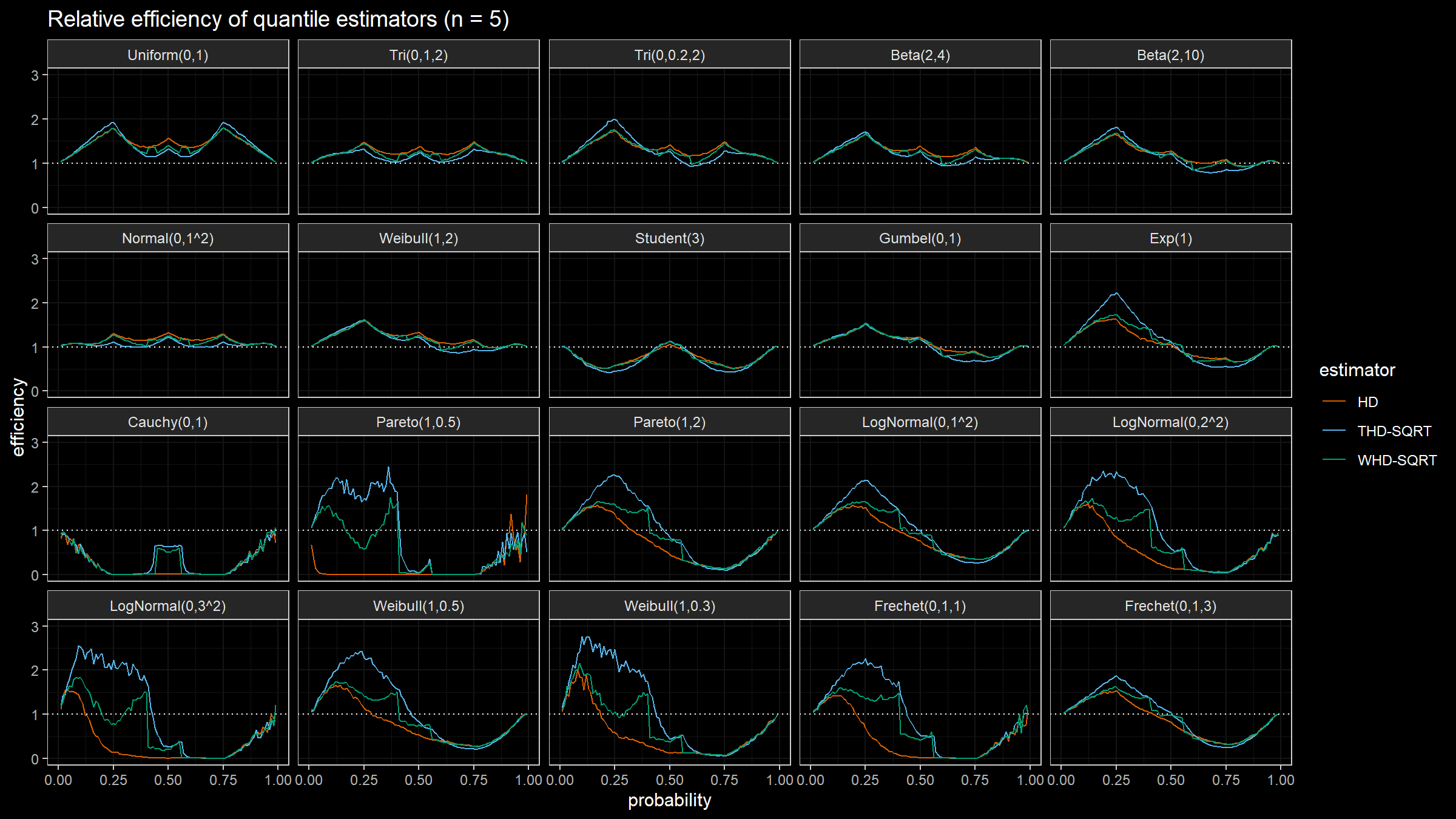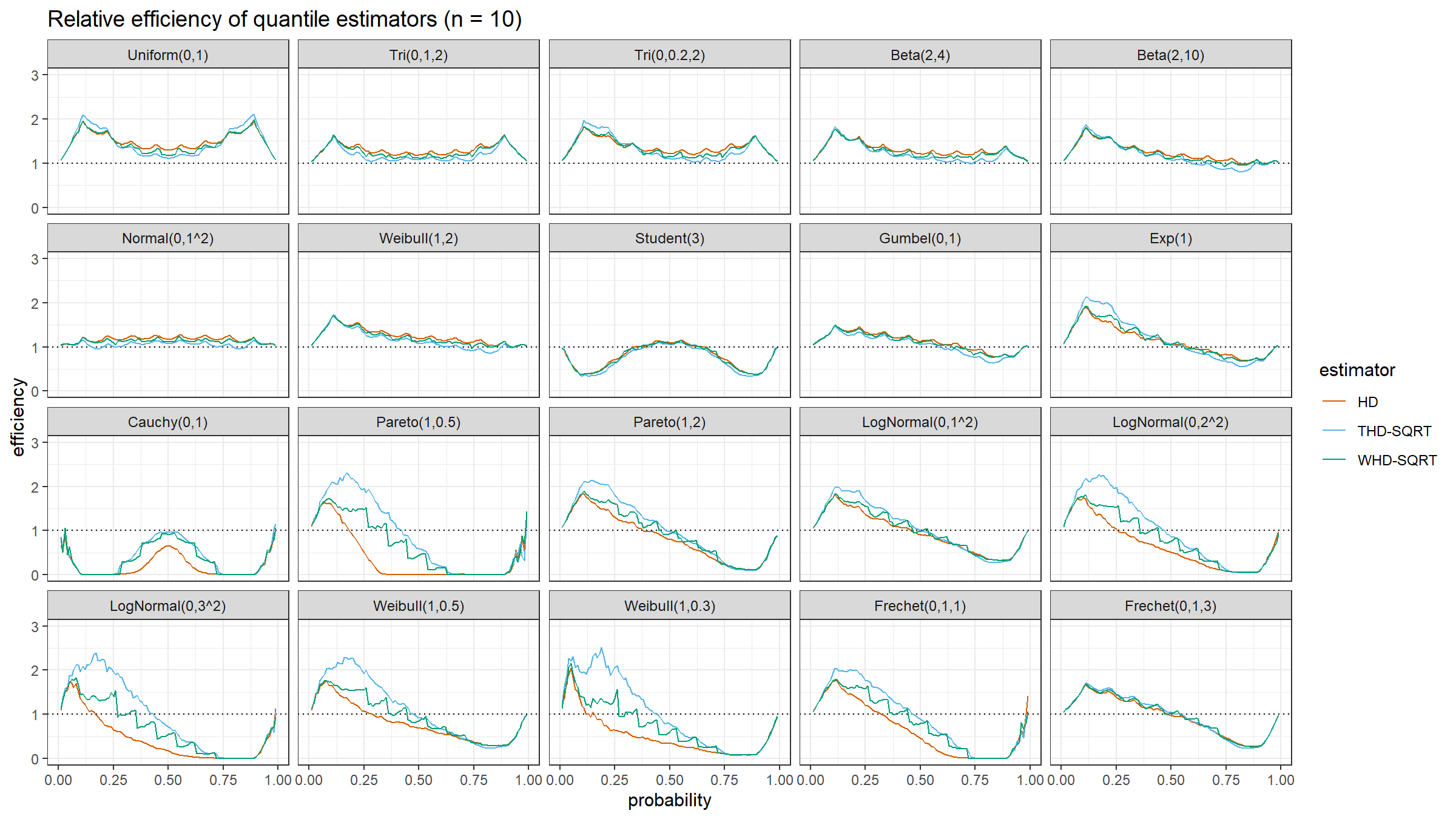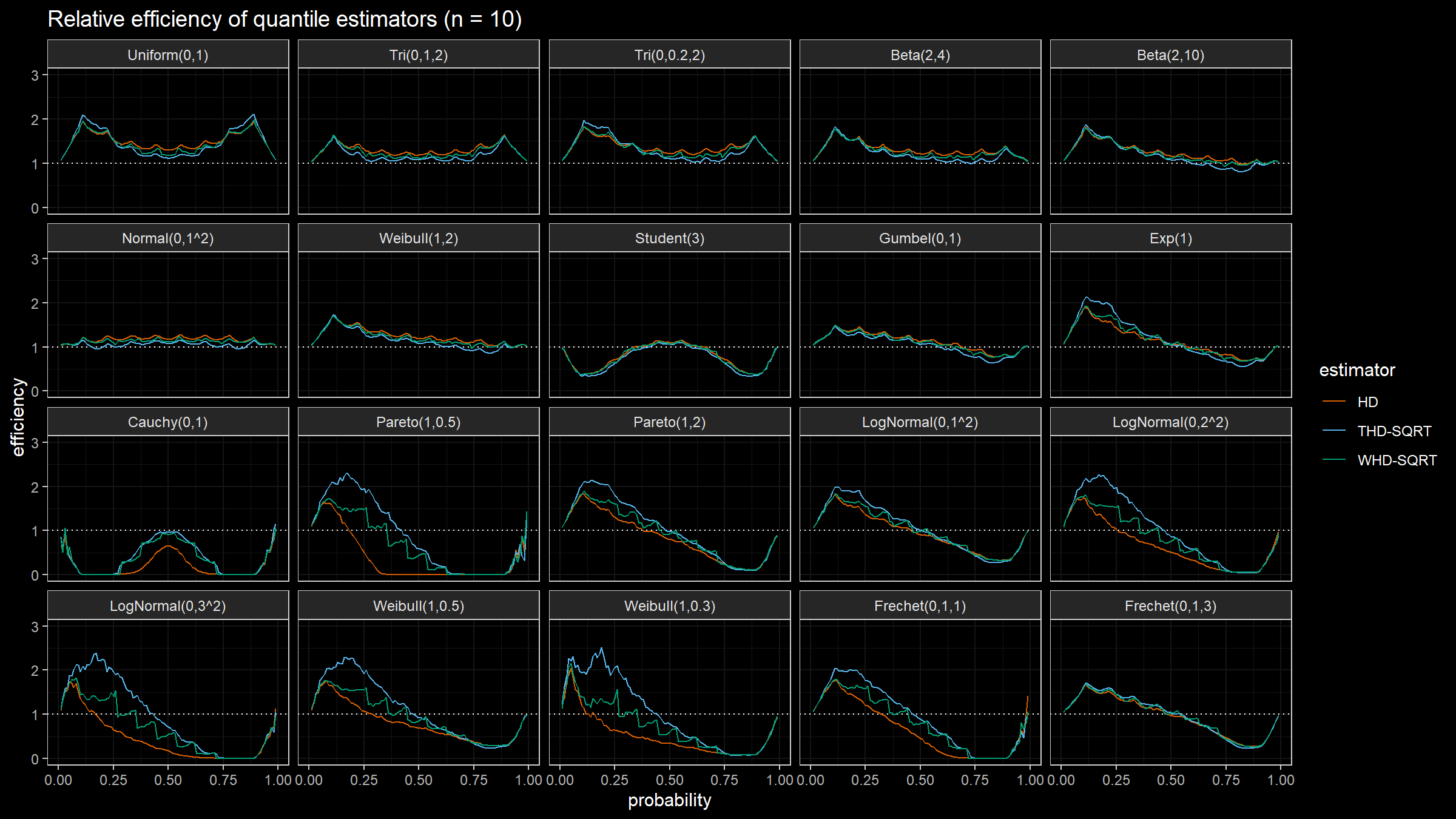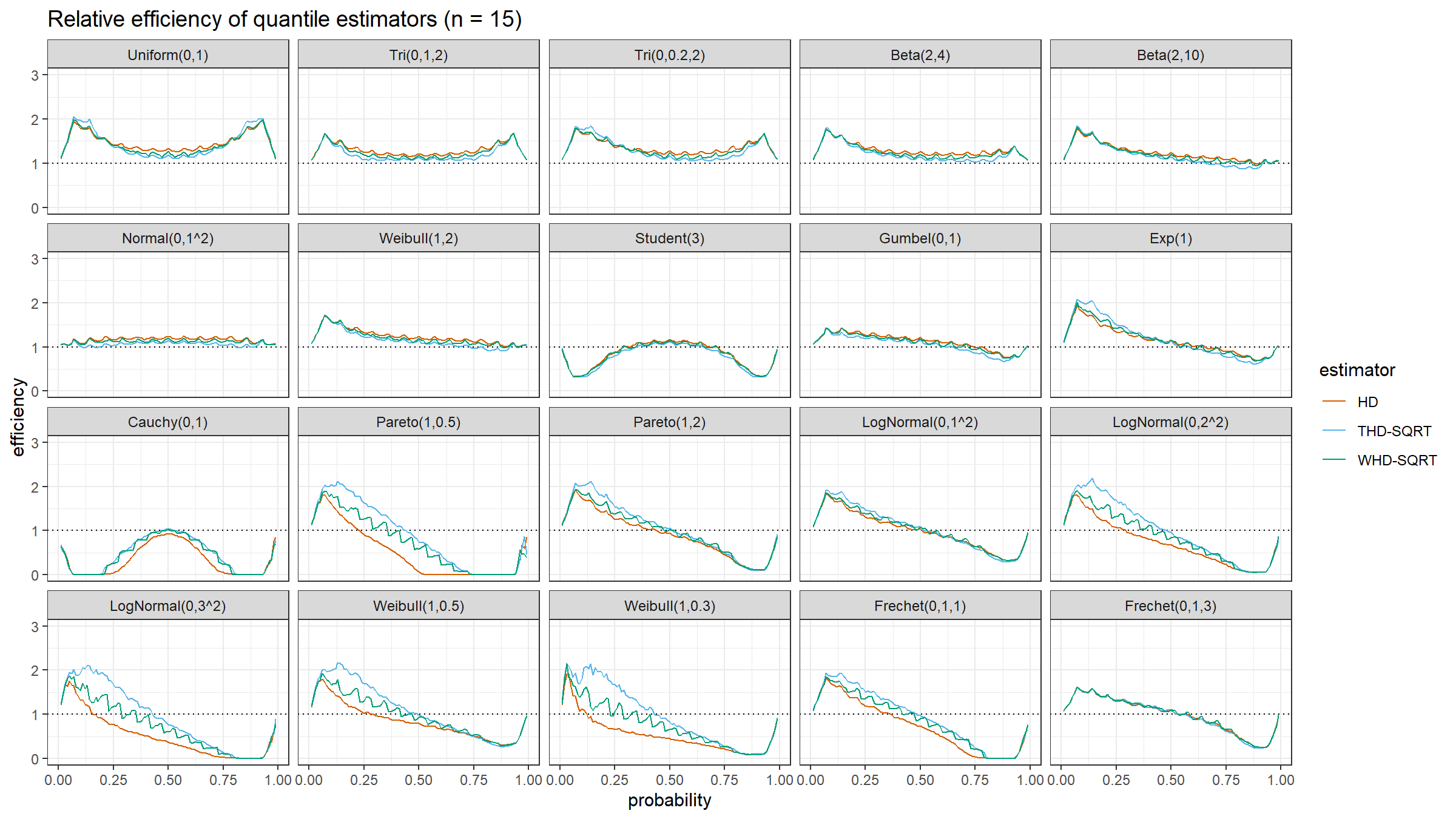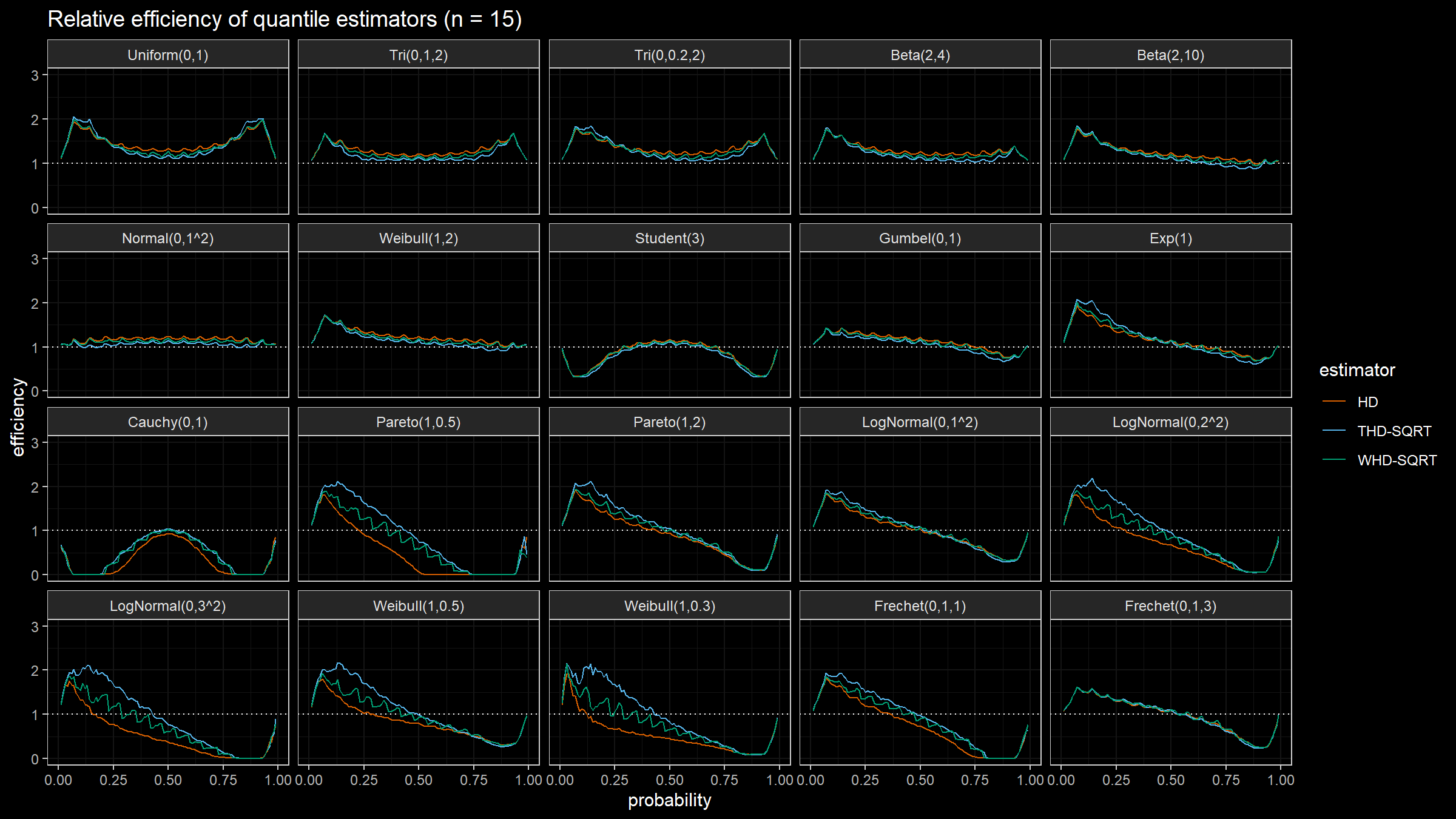Quantile estimators based on k order statistics, Part 8: Winsorized Harrell-Davis quantile estimator
In the previous post, we have discussed the trimmed modification of the Harrell-Davis quantile estimator based on the highest density interval of size $\sqrt{n}/n$. This quantile estimator showed a decent level of statistical efficiency. However, the research wouldn’t be complete without comparison with the winsorized modification. Let’s fix it!
All posts from this series:
- Quantile estimators based on k order statistics, Part 1: Motivation (2021-08-03)
- Quantile estimators based on k order statistics, Part 2: Extending Hyndman-Fan equations (2021-08-10)
- Quantile estimators based on k order statistics, Part 3: Playing with the Beta function (2021-08-17)
- Quantile estimators based on k order statistics, Part 4: Adopting trimmed Harrell-Davis quantile estimator (2021-08-24)
- Quantile estimators based on k order statistics, Part 5: Improving trimmed Harrell-Davis quantile estimator (2021-08-31)
- Quantile estimators based on k order statistics, Part 6: Continuous trimmed Harrell-Davis quantile estimator (2021-09-07)
- Quantile estimators based on k order statistics, Part 7: Optimal threshold for the trimmed Harrell-Davis quantile estimator (2021-09-14)
- Quantile estimators based on k order statistics, Part 8: Winsorized Harrell-Davis quantile estimator (2021-09-21)
The approach
The general idea is the same that was used in one of the previous posts. We express the estimation of the $p^\textrm{th}$ quantile as a weighted sum of all order statistics:
$$ \begin{gather*} q_p = \sum_{i=1}^{n} W_{i} \cdot x_i,\\ W_{i} = F(r_i) - F(l_i),\\ l_i = (i - 1) / n, \quad r_i = i / n, \end{gather*} $$where $F$ is a CDF function of a specific distribution. In the case of the Harrell-Davis quantile estimator, we use the Beta distribution. Thus, $F$ could be expressed via regularized incomplete beta function $I_x(\alpha, \beta)$:
$$ F_{\operatorname{HD}}(u) = I_u(\alpha, \beta), \quad \alpha = (n+1)p, \quad \beta = (n+1)(1 - p). $$In the case of the winsorized Harrell-Davis quantile estimator, we use a part of the Beta distribution inside the $[L,\, R]$ window. In addition, we use the tails of the Beta distribution, but we replace “tailed elements” with elements that correspond to $L$ and $R$ positions. Thus, $F$ could be expressed as rescaled regularized incomplete beta function inside the given window:
$$ F_{\operatorname{WHD}}(u) = \left\{ \begin{array}{lcrcllr} 0 & \textrm{for} & & & u & < & L, \\ F_{\operatorname{HD}}(u) & \textrm{for} & L & \leq & u & \leq & R, \\ 1 & \textrm{for} & R & < & u. & & \end{array} \right. $$In the previous post, we discussed the idea of choosing $L$ and $R$ as the highest density interval of the given width $R-L$:
$$ R-L = \frac{\sqrt{n}}{n}. $$Numerical simulations
The relative efficiency value depends on five parameters:
- Target quantile estimator
- Baseline quantile estimator
- Estimated quantile $p$
- Sample size $n$
- Distribution
As target quantile estimators, we use:
HD: Classic Harrell-Davis quantile estimatorTHD-SQRT: The described in the previous post trimmed modification of the Harrell-Davis quantile estimator based on highest density interval of size $\sqrt{n}/n$.WHD-SQRT: The described above winsorized modification of the Harrell-Davis quantile estimator based on highest density interval of size $\sqrt{n}/n$.
The conventional baseline quantile estimator in such simulations is the traditional quantile estimator that is defined as a linear combination of two subsequent order statistics. To be more specific, we are going to use the Type 7 quantile estimator from the Hyndman-Fan classification or HF7. It can be expressed as follows (assuming one-based indexing):
$$ Q_{HF7}(p) = x_{(\lfloor h \rfloor)}+(h-\lfloor h \rfloor)(x_{(\lfloor h \rfloor+1)})-x_{(\lfloor h \rfloor)},\quad h = (n-1)p+1. $$Thus, we are going to estimate the relative efficiency of the trimmed and winsorized Harrell-Davis quantile estimators with different percentage values against the traditional quantile estimator HF7. For the $p^\textrm{th}$ quantile, the classic relative efficiency can be calculated as the ratio of the estimator mean squared errors ($\textrm{MSE}$):
$$ \textrm{Efficiency}(p) = \dfrac{\textrm{MSE}(Q_{HF7}, p)}{\textrm{MSE}(Q_{\textrm{Target}}, p)} = \dfrac{\operatorname{E}[(Q_{HF7}(p) - \theta(p))^2]}{\operatorname{E}[(Q_{\textrm{Target}}(p) - \theta(p))^2]} $$where $\theta(p)$ is the true value of the $p^\textrm{th}$ quantile. The $\textrm{MSE}$ value depends on the sample size $n$, so it should be calculated independently for each sample size value.
We are also going to use the following distributions:
Uniform(0,1): Continuous uniform distribution; $a = 0,\, b = 1$Tri(0,1,2): Triangular distribution; $a = 0,\, c = 1,\, b = 2$Tri(0,0.2,2): Triangular distribution; $a = 0,\, c = 0.2,\, b = 2$Beta(2,4): Beta distribution; $\alpha = 2,\, \beta = 4$Beta(2,10): Beta distribution; $\alpha = 2,\, \beta = 10$Normal(0,1^2): Standard normal distribution; $\mu = 0,\, \sigma = 1$Weibull(1,2): Weibull distribution; $\lambda = 1\;\textrm{(scale)},\, k = 2\;\textrm{(shape)}$Student(3): Student distribution; $\nu = 3\;\textrm{(degrees of freedom)}$Gumbel(0,1): Gumbel distribution; $\mu = 0\;\textrm{(location)},\, \beta = 1\;\textrm{(scale)}$Exp(1): Exponential distribution; $\lambda = 1\;\textrm{(rate)}$Cauchy(0,1): Standard Cauchy distribution; $x_0 = 0\;\textrm{(location)},\,\gamma = 1\;\textrm{(scale)}$Pareto(1,0.5): Pareto distribution; $x_m = 1\;\textrm{(scale)},\, \alpha = 0.5\;\textrm{(shape)}$Pareto(1,2): Pareto distribution; $x_m = 1\;\textrm{(scale)},\, \alpha = 2\;\textrm{(shape)}$LogNormal(0,1^2): Log-normal distribution; $\mu = 0, \sigma = 1$LogNormal(0,2^2): Log-normal distribution; $\mu = 0, \sigma = 2$LogNormal(0,3^2): Log-normal distribution; $\mu = 0, \sigma = 3$Weibull(1,0.5): Weibull distribution; $\lambda = 1\;\textrm{(scale)},\, k = 0.5\;\textrm{(shape)}$Weibull(1,0.3): Weibull distribution; $\lambda = 1\;\textrm{(scale)},\, k = 0.3\;\textrm{(shape)}$Frechet(0,1,1): Frechet distribution; $m=0\;\textrm{(location)},\, s = 1\;\textrm{(scale)},\, \alpha = 1\;\textrm{(shape)}$Frechet(0,1,3): Frechet distribution; $m=0\;\textrm{(location)},\, s = 1\;\textrm{(scale)},\, \alpha = 3\;\textrm{(shape)}$
Simulation Results
Conclusion
One of the biggest drawbacks of the winsorized modification of the Harrell-Davis quantile estimator is the stair-like pattern which we can observe in the above images. Such a phenomenon could be easily explained. If we enumerate all the quantile values from 0 to 1, the $[L;R]$ window moves from left to right. At some specific moments, $L$ and $R$ cross the border between elements. Once they do that, the estimator switches the index of the winsorized elements that get “extra” weight. Thus, the winsorized modification of the Harrell-Davis quantile estimator is not smooth, and it has low statistical efficiency around these “switching points.”

